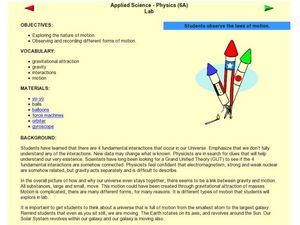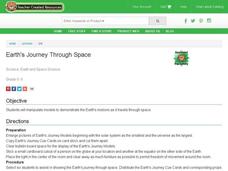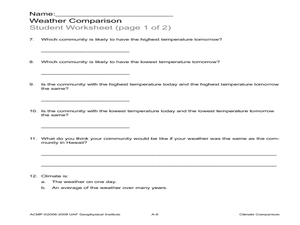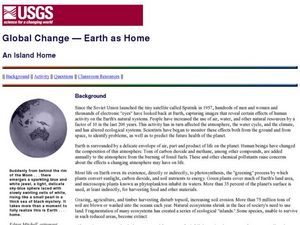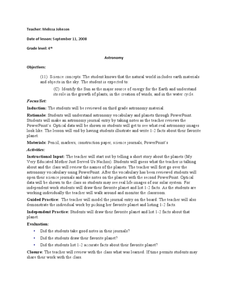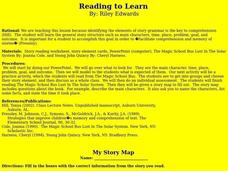Curated OER
Circles to Spheres
Students investigate circles and spheres. In this space shapes lesson plan, students compare and contrast two-dimensional and three-dimensional shapes. Students investigate the relationship between plane and space shapes.
Curated OER
Meteorites
Students model how meteors fall to the surface of planets. In this space science lesson, students identify different types of meteorites using an interactive online website. They investigate the relationship between a meteorite's size...
Curated OER
Exploring Meteorite Mysteries: Building Blocks of Planets
Students simulate the formation of chondrites and asteroids. In this astronomy lesson plan, students demonstrate accretion using balloons and static electricity. They compare and contrast their models to the actual process of chondrites...
Curated OER
Two Views of the Universe
Students build the two models of the universe created by Aristotle and Copernicus. They compare and contrast the two universes. They create hypothesis on how each model functions.
Curated OER
Planetary Diversity
Students explore the infrared radiation and the part of the spectrum that is not always visible. In this electromagnetic lesson students complete a lab activity on the different wavelengths.
Curated OER
I, Robot: Chapter Four- Catch That Rabbit
Sixth graders explore the development of technology in the 20th century. In this chapter lesson, 6th graders read and discuss the literary content of chapter four, I, Robot by Isaac Asimov. They research the technology that was...
Curated OER
Lunar Lollipops
Students simulate the phases of the moon using a lamp and styrofoam balls. In this lunar phases lesson, students stand around a lamp and act as Earth. They hold styrofoam balls and rotate to show the phases of the moon.
Curated OER
Impact Craters: Holes in the Ground!
Students simulate crater formation through a lab activity. In this space science lesson, students calculate how much energy is transferred during meteorite impact. They identify different factors affecting the size and depth of craters...
Curated OER
Motion Experiment
Young scholars experiment with the laws of motion. In this motion lesson, students explore Newton's Laws of Motion. Young scholars work in groups experimenting with different objects and observing different types of motion.
Curated OER
Earth's Journey Through Space
Learners arrange various pictures of the Earth to identify its journey through space. In this Earth's rotation instructional activity, students use models of the Earth and demonstrate its journey through space. Learners complete the...
Curated OER
Map Your House
Students are introduced to the concepts of maps as scale models of the whole. After a brief lecture on creating and using an accurate scale when drawing and reading a map. They create a scale drawing of the floorplan of their homes.
Curated OER
Layering the Soil
Students study and classify soil. In this soil science instructional activity, students classify soil by texture and size and study soil horizons. Students label the soil types with their specific soil horizon and learn about permafrost....
Curated OER
To Boldly Go Where No One Has Gone Before
Students study pictures of space vehicles and make their own space vehicle. In this space vehicle activity, students study pictures of the vehicles and compare and contrast the pictures. Students classify the space crafts and then create...
Curated OER
Climate Comparison
Young scholars explore climate regions. In this climate lesson, students examine the climate regions of Alaska as well as the state of Hawaii. Young scholars research selected Internet sources to gather information regarding the climates...
S2tem Centers SC
Seasons
Winter, spring, summer, and fall—take the learning of the seasons beyond the elementary level to the middle school classroom. Curious learners begin by watching videos about the seasons and the rotation of planet Earth. Then,...
Science 4 Inquiry
The Impact of the Sun and Moon on Tides
In 150 BC, Seleucus of Seleucia theorized that the moon causes the tides. Scholars learn about what causes tides by studying the interactions of gravity between the sun, moon, and Earth. They use technology to formalize otherwise...
Curated OER
Alternative Energy
Students discover types of energy. In this physics lesson, students discuss ways to power a car a design a model car kit with an alternative form of energy.
Curated OER
Weather, Sea Level Rise and Climate Change Course
Students explain the impact of glacial melting to global climate change. In this environmental science lesson, students design an experiment to investigate the effect of salinity change to melting glaciers. They share their results to...
Curated OER
Global Change- Earth as Home
Students create their own environment. In this environmental protection lesson, students pretend they are the owners of a tropical island. They create jobs for the citizens and develop the island as a model environment.
Curated OER
Lenses and Telescopes
Students examine telescope construction. In this telescope lesson, students examine the lenses used in telescopes by exploring with convex and concave lenses.
Ventura County Air Pollution Control District
Effects of Global Warming
Your learners have probably heard of climate change, but do they really understand what it is? Study the history, details, and future implications of global warming and the greenhouse effect with a set of activities designed for an...
Curated OER
Astronomy
Students complete a series of activities to better understand space studies. In this space science instructional activity, the teacher is provided with a number of activities for students to complete such as finding words that begin with...
Curated OER
Reading to Learn
Students complete story maps in this lesson. Students read "The Magic School Bus", and get into groups to choose their story element. Each group shares their information with the class. They then complete a story map for a book read...
Curated OER
Earth, Moon, Mars Balloons
Students demonstrate size and orbits of Earth, Moon, and Mars. In this space science lesson plan, students will use balloons to show how the size and distance between the planets and satellite compare.










